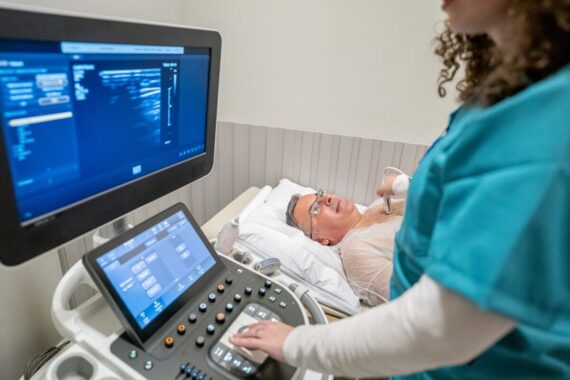GP specialist in Cardiology Dr Yassir Javaid explains the key points for understanding and managing heart failure in general practice. This series showcases content from our Pulse Reference site, which supports GPs in making diagnoses. We are expanding this service to include advice on managing and treating conditions
Accepted definition and diagnostic criteria
Heart failure is a devastating clinical syndrome characterised by a constellation of symptoms and signs in the presence of reduced cardiac function. Typical symptoms include breathlessness, fatigue and ankle swelling, and common clinical findings include an elevated jugular venous pressure (JVP) and pulmonary congestion.
According to both NICE and European Society of Cardiology (ESC) guidelines, in addition to the clinical picture, there must be evidence of a structural and/or functional abnormality of the heart that results in increased intracardiac pressures and/or inadequate cardiac output at rest and/or exertion.
Heart failure can be classified according to the ejection fraction (EF) of the left ventricle (LV) which represents the percentage of blood in the LV that is ejected after each systole. This classification is important as it influences management. Echocardiography is the key readily available and cost-effective investigation to establish a diagnosis.
Epidemiology
Heart failure (HF) has been described as an epidemic and accounts for 5% of NHS medical emergency admissions.
The average age of diagnosis is around 77 years and the incidence is higher in men, which is likely due to earlier onset of CAD. The overall prevalence of HF is 1-2% but is much higher in older age groups. The prevalence increases from one in 35 among people aged 65-74 years to one in seven among people aged 85 years or older. The prevalence is likely to continue to rise due to the ageing of the population and increasing rates of obesity.
The most common aetiologies include CAD, cardiomyopathy and hypertension. Valve disease accounts for around 10% of cases but this is likely to increase as degenerative aortic stenosis becomes more common.
Diagnosis
Diagnosis starts with identifying signs and symptoms that may be suggestive of HF, particularly in patients with known risk factors, such as CAD, hypertension and diabetes. Symptoms include breathlessness on exertion and breathlessness on lying down, fatigue, lower limb swelling and weakness. Typical signs include peripheral and pulmonary congestion, an elevated JVP and third heart sound. The key screening test is the NT-proBNP which has a high negative predictive value but if elevated, warrants further investigation with echocardiography. If severely elevated (>2000 ng/litre) the assessment should be undertaken within 2 weeks. Clinical assessment should also include a 12-lead ECG, FBC and biochemistry to rule out atrial fibrillation, anaemia, diabetes and hyperthyroidism. CXR and spirometry can also be useful to identify chronic lung disease such as COPD, a very common comorbidity in heart failure.
Echocardiography not only confirms or refutes the diagnosis of heart failure but also points to the likely aetiology – eg, CAD, dilated cardiomyopathy or valve disease. All new diagnoses should be considered for specialist review to determine the onward management plan and further investigations. For patients with HF secondary to valve disease a prompt MDT review prior to likely valve intervention should be undertaken. The commonest valve lesion encountered in the UK is aortic stenosis and transcatheter aortic valve implantation (TAVI) is an option even in patients with co-morbidities not deemed suitable for surgery.
HFrEF refers to patients with a LVEF of ≤40% and HFmrEF 41-49%. Around 50% of HF patients have a preserved LVEF, ≥50%, so-called HFpEF. In HFpEF the contractility of the heart is relatively preserved, but there is compromised filling due to increased stiffness of the left ventricle.
Comorbidity in HF is almost inevitable as HF is often the culmination of chronic disease processes such as IHD, hypertension and valve disease and its treatment may precipitate comorbidities such as gout, erectile dysfunction and AKI. Obesity, atrial fibrillation and obstructive sleep apnoea are particularly common comorbidities in HFpEF and should be identified and managed appropriately.
Treatment
All patients with HF should be offered counselling and advice in relation to smoking cessation, alcohol moderation, reduction of salt intake and exercise. HFrEF (previously known as LV systolic dysfunction [LVSD]) if left untreated has a prognosis worse than the majority of cancers.2 Yet the best possible treatment, much of which can and probably should be delivered in primary care, can at least double survival.3
Patients with HFrEF should now be considered for four pillars of treatment according to the very latest ESC guidelines: ACE inhibitor/ARB/ARNI in addition to a beta blocker, MRA and SGLT2i (dapagliflozin or empagliflozin) with doses optimised. Both dapagliflozin and empagliflozin have the advantage of not requiring titration and NICE recommends that they can be initiated on the advice of a specialist. Flexibly dosed loop diuretics should be used to relieve fluid congestion.
According to the ESC, the same pillars of treatment should be considered for patients with HFmrEF though it should be noted the evidence for benefit is less compelling in this cohort.
In patients with HFpEF, SGLT2is are the only specifically licenced treatments that have been proven to offer benefit and the 2023 update to the ESC guidelines gave a class 1A recommendation for their use in HFpEF. Indeed, SGLT2is now have a class 1A recommendation across the whole EF spectrum of HF.
In patients with severely reduced LVEF (≤35%), there is a particularly high risk of sudden cardiac death due to ventricular arrhythmias and these patients should be considered for an implantable cardioverter defibrillator (ICD) which offers proven mortality benefit in this cohort. Patients who develop significantly broadened QRS complexes on ECG in addition to having an LVEF ≤35%, particularly if left bundle branch block (LBBB), should be considered for assessment of biventricular pacing or cardiac resynchronisation therapy (CRT) which can enhance both quality as well as quantity of life.
Management of comorbidities
HF management should factor in comorbidity to optimise outcomes. In patients with residual dyspnoea despite optimal treatment, the possibility of co-existing HFrEF in a patient with COPD and vice-versa should always be considered as the two chronic conditions commonly overlapdue to common risk factors such as smoking.4
Undiagnosed and untreated COPD in patients with HF can not only significantly worsen symptoms and quality of life but ultimately lead to right sided HF secondary to pulmonary hypertension; a raised JVP and peripheral oedema are clues to this. Significant tricuspid regurgitation and elevated right ventricular systolic pressure on echocardiography are suggestive of significant pulmonary hypertension.
Other pitfalls include inappropriately excluding beta-blocker therapy to HFrEF patients with COPD. Of the patients that are coded as LVSD in primary care, 86% are on an ACE inhibitor or ARB but only 65% are on both an ACE inhibitor/ARB and beta blocker.6 Across regions in England, exception reporting rates for beta blockers vary more than four-fold.6 If there is anxiety about the use of beta blockade, the most prognostically beneficial therapy for patients with HFrEF, in patients with obstructive airways disease, then spirometry to rule out significant reversibility should provide reassurance. Exacerbations of COPD should be managed without high-dose oral steroid treatment if at all possible to avoid worsening fluid retention from heart failure.
A recent Cochrane review7 confirmed exercise as an excellent treatment modality for HF, demonstrating a 60% relative risk reduction for hospitalisation for exercise-based rehabilitation. In the absence of provision of such programmes in the UK, all patients with HF should be encouraged to be active. Erectile dysfunction is a common co-morbidity in HF and unless patients are on nitrate treatment, phosphodiesterase inhibitors should be offered, if appropriate, to help promote an active lifestyle.
Prognosis
Heart failure is usually a progressive condition causing increasing disability and is often eventually fatal, often secondary to a sudden cardiac event. However, it’s almost impossible to predict the prognosis and trajectory as it’s a very heterogenous condition with a broad spectrum. We know that prompt diagnosis and treatment, particularly in HFrEF, can significantly slow progression, increase life expectancy and quality of life as well as reduce the risk of hospitalisation. Left undiagnosed and untreated, it is associated with a prognosis worse than most cancers.
Dr Yassir Javaid is a GPwSI in Cardiology at Imperial College Healthcare Trust
References
1. Cowie M. The heart failure epidemic: a UK perspective. Echo Res Pract 2017;4(1):R15–R20
2. Stewart S, MacIntyre K, Hole D et al. More ‘malignant’ than cancer? Five-year survival following a first admission for heart failure. Eur J Heart Fail 2001;3:315-322
3. Levy W, Mozaffarian D, Linker T et al. The Seattle Heart Failure Model. Prediction of survival in heart failure. Circulation 2006;113:1424-1433
4. Hawkins N, Petrie M, Jhund P et al. Heart failure and chronic obstructive pulmonary disease: diagnostic pitfalls and epidemiology. Eur J Heart Fail 2009;11(2):130–139
5. Nkomo V, Gardin J, Skelton T et al. Burden of valvular heart diseases: a population-based study. Lancet 2006;368:1005-1011
6. NHS England/NHS Digital. Quality and Outcomes Framework (QOF) 2014−15. October 2015
7. Taylor R, Sagar V, Davies E et al. Exercise-based rehabilitation for heart failure. Cochrane Database Syst Rev 2019 Jan 29;1(1):CD003331
8. NICE. Chronic heart failure in adults: diagnosis and management. NG106. 2018
9. ESC. 2023 Focused Update of the 2021 ESC Guidelines for the diagnosis and treatment of acute and chronic heart failure. August 2023

















